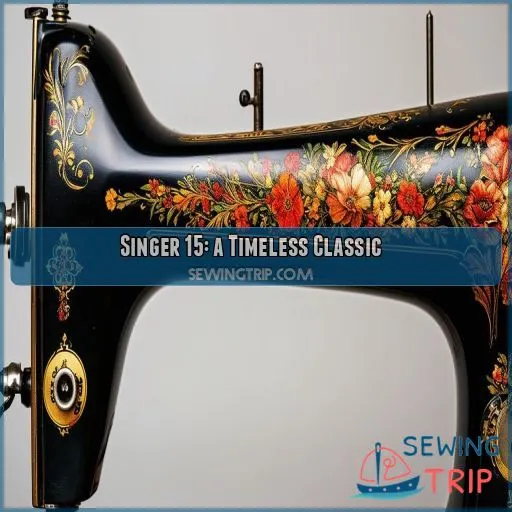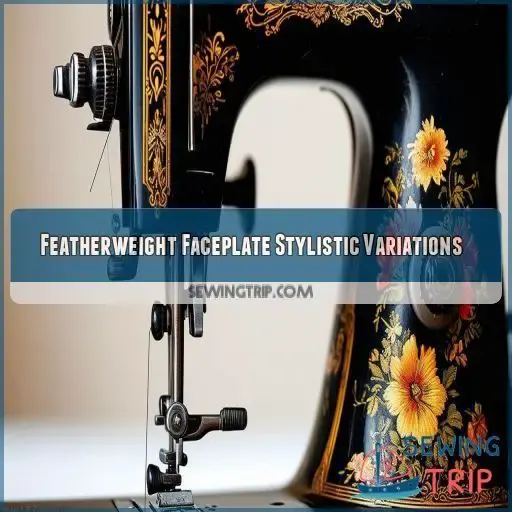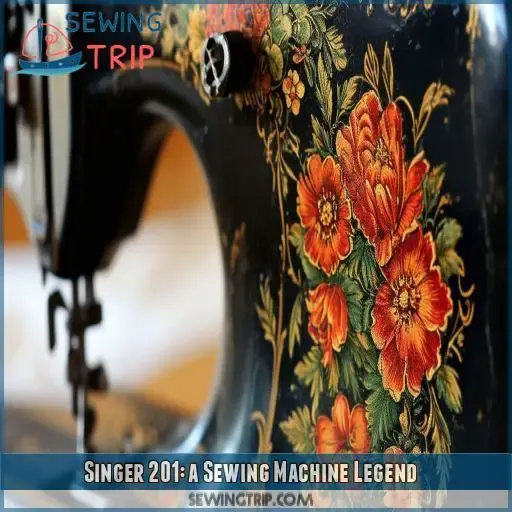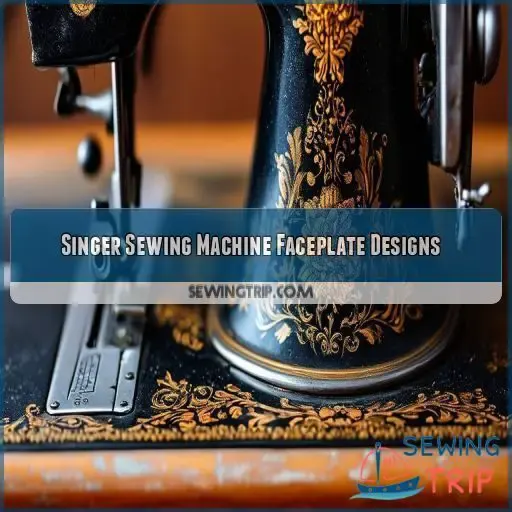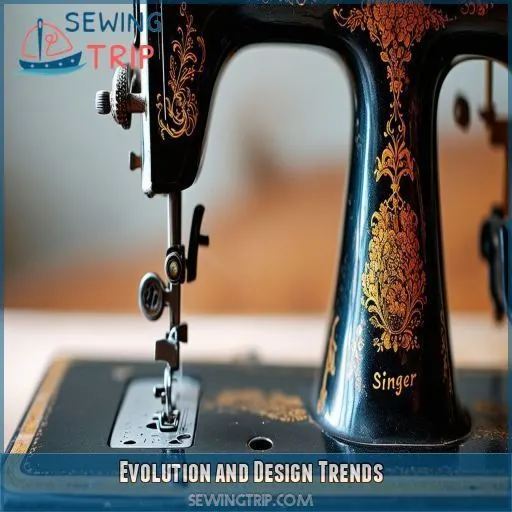This site is supported by our readers. We may earn a commission, at no cost to you, if you purchase through links.
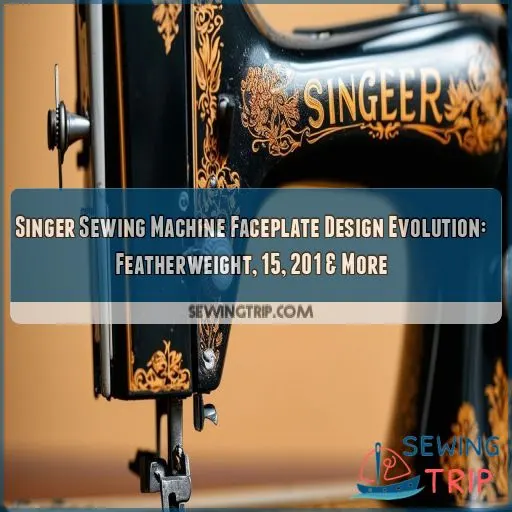
The Featherweight series also showcased an array of faceplate designs. The most common US version from 1947 to 1957 had a striated faceplate with an "art deco" vibe. Meanwhile, UK Featherweights from 1947 to 1948 sported longer thread guides and different part number locations.
Each faceplate variation tells a story, and there’s more to uncover.
Table Of Contents
Key Takeaways
- Singer sewing machines, like the classic 15 and the legendary 201, have evolved with stylish faceplates, from chrome scrollwork to modern aluminum bodies, offering elegance, functionality, and a touch of personal flair.
- The Singer 15, introduced in 1895, set the standard for needle design and tension assembly, while later models introduced adjustable lower thread tension and a removable bobbin case, making it a durable and versatile favorite.
- Rare Featherweight faceplates stand out with unique finishes and designs, from mirror-like surfaces to black oxide, showcasing the machine’s early history and global reach.
- The Singer 201’s reputation for legendary stitch quality and its durable design, featuring a direct-drive gear mechanism, solidifies its status as a high-end model and a collector’s dream.
Singer 15: a Timeless Classic
Singer 15 has been a beloved classic for over a century, with its design and innovations influencing sewing machines ever since. Let’s take a closer look at what makes this machine so special and explore its evolution, features, and impact on the sewing world.
Early Models and Evolution
Let’s take a trip down memory lane and explore the early models and their evolution:
- Early Days, Treadle On: The Singer 15’s early models were primarily treadle or cabinet versions, with some hand crank options. These machines were a step above the Improved Family machine, from which they evolved.
- Unique Tension, Special Needle: Singer 15’s original faceplate boasted a built-in tension assembly, a feature that set it apart. It also introduced the 15×1 needle design, which later became standard for sewing machines.
- Bobbin Evolution: Early on, the "long beak" shuttle was replaced by a removable bobbin case in 1888, streamlining the sewing experience.
Innovative Features and Designs
The Singer 15 is a legend in the sewing world, and its impact is still felt today.
Introduced way back in 1895, this machine has some unique features that set it apart.
The original Singer 15 had a tension assembly built right into the faceplate—pretty clever, right?
And that’s not all; it also introduced the 15×1 needle design, which later became the go-to for most sewing machines.
Bobbin Case and Hook System
The Singer 15’s bobbin case and hook system are a great example of its timeless design.
Early models used a "long beak" shuttle, but in 1888, a game-changing innovation arrived: a removable bobbin case.
This paved the way for the class 15-11, which introduced a new bobbin case and hook system, setting the standard for most sewing machine makers.
The class 15 bobbin case offered a key advantage: the ability to adjust lower thread tension.
Variants and Specialized Models
The Singer 15 series has an impressive range of variants and specialized models, catering to various sewing needs and preferences. Here’s a glimpse into the diverse world of Singer 15 machines:
- Specialized Uses: From cloth to leather to embroidery, the Singer 15 series includes models designed for specific tasks, ensuring precise and efficient work.
- Industrial Versions: Meet the Singer 16, the industrial powerhouse. It’s the Singer 15’s tougher sibling, built for heavy-duty use and long hours of continuous sewing.
- Drop Feeds and Kimono Machines: Some Singer 15 variants offer drop feeds, perfect for free-motion or embroidery work. The 15K70-15K73 and 15K80-15K85 models, exclusive to Japan, are specialized for kimono sewing, showcasing Singer’s global reach and adaptability.
Featherweight Faceplate Stylistic Variations
Let’s take a closer look at how the Singer Featherweight faceplate changed over time. From its early days in the 1930s to when they started using molded and painted designs in the ’60s, we’ll explore the different styles that make this sewing machine so special.
Blackside and UK Faceplates
Let’s take a closer look at Featherweight faceplates, specifically the Blackside and UK variations. Each of these faceplates has its own unique style and story to tell.
The Blackside Featherweight (1941 & 1945):
This faceplate is a rare treat for collectors. It features the same scrollwork as its predecessor but with a unique black oxide finish and a longer thread guide. Keep your eyes peeled for this one, as it’s a real standout in the Featherweight family.
UK Featherweight Faceplates (1947-1948):
Across the pond, the UK Featherweight faceplates held onto the scrolled design but with a twist. They sported a longer thread guide and a different part number location, giving them a distinct identity.
Later UK Scrolled Faceplate (1948-1952):
The UK scrolled faceplate evolved with a slight tweak to the part number and thread guide, keeping things fresh and unique.
Transition to Molded and Painted Designs
The Featherweight faceplate went through a big change in the 1960s, adopting a more modern look. Here’s the lowdown on this shift:
- Modern Makeover: The molded and painted faceplate (1961-1969) was a big departure from the flat, chromed designs. It embraced a more modern and streamlined look, reflecting the evolving tastes of the time.
- Final Featherweight: The White Featherweight faceplate (1964-1969) was the last of the Featherweight series, marking the end of an era of iconic design.
- Manufacturing Milestones: This change highlights advancements in manufacturing techniques and materials, showing how Singer adapted to changing trends.
- Streamlined Style: The new faceplate design was a sleek update, emphasizing simplicity and a contemporary aesthetic.
- Enduring Evolution: Singer’s willingness to experiment with faceplate designs underscores the company’s commitment to innovation and style, ensuring their machines remain timeless classics.
Singer 201: a Sewing Machine Legend
Now, let’s take a closer look at the legendary Singer 201, a sewing machine that’s made a big impact on sewing. Made from 1934 to 1961, mostly in the USA and UK, this high-end model had a durable design, a full rotary hook, and super-hard meshing gears. It was the bee’s knees.
History and Production
The Singer 201, a legend in the sewing world, was manufactured from 1934 to 1961, primarily in the USA and UK. It was the highest-end model of its time, making it a pricey purchase. The 201D was produced in Germany, and the 201P was assembled in Australia using UK parts.
Design and Features
The Singer 201’s design boasted some impressive features that made it a legend in the sewing world.
It had a full rotary hook and high-carbon super-hard meshing gears, giving it serious durability.
This machine could handle any fabric you threw at it thanks to its large harp space.
It was a straight stitch machine with a reverse function, and Singer offered a bunch of attachments to make your sewing projects a breeze, like buttonholers, zigzag attachments, and blind stitch attachments.
It used a drop-in class 66 bobbin, and had a unique needle insertion—flat side facing left and threaded from right to left.
You could also adjust the tension and stitch length with a numbered dial.
Model Variations and Legacy
Now, let’s take a closer look at the different versions of the classic Singer 201. Here’s a list of the main model variations you should know about:
- Model 201K4 (Cast Iron): This model has a sturdy cast iron body, weighing in at approximately 30 lbs.
- Model 201K (Aluminum): Introduced in the 1950s, this version has a lightweight aluminum body, reducing the weight to around 24 lbs.
- Model 201K23: A later model offering a solid balance wheel, available in classic black or elegant beige.
- Model 201P: Assembled in Australia, this model uses parts sourced from the UK, showcasing global collaboration in its production.
- Model 201D: These cast iron models were crafted in Germany, adding an international flair to the 201 series.
Enduring Appeal and Direct Drive Mechanism
The Singer 201’s enduring appeal? It boils down to two words: stitch quality. Even today, its unique direct drive gear mechanism delivers exceptional stitches. No wonder it’s still hailed as the best sewing machine ever made by enthusiasts. Add in its hefty price tag and rare black 201K models, and you’ve got a collector’s dream.
Singer Sewing Machine Faceplate Designs
Singer sewing machines have evolved over the years, and their faceplates have undergone a stylish transformation. From the classic chrome scrollwork to the modern aluminum body, Singer has offered a range of designs to suit different tastes and needs.
Chrome Scrollwork and Back Access Cover
The early Singer sewing machines, including the 15 and 201 models, featured a chrome scrollwork faceplate and a matching back access cover.
This design aesthetic added a touch of elegance to the machines, which were often mounted into tables or cabinets.
The chrome scrollwork faceplate was a signature look for these classic sewing machines, and it’s a design that has stood the test of time, with many collectors and enthusiasts seeking out these vintage models.
Aluminum Body and Modern Look
In the 1950s, Singer introduced an updated design with an aluminum body, giving the machine a more modern aesthetic. This change also made the machine lighter but also marked a shift to a more contemporary style. While the previous models featured chrome scrollwork, this new aluminum version offered a sleek and streamlined look.
Hand-Crank, Treadle, and Electric Versions
The Singer 201 was a versatile machine, offering hand-crank, treadle, and electric versions. These options gave users control over their sewing experience, catering to their preferences and needs. Whether you cranked by hand, powered with your feet, or plugged into electricity, the Singer 201 adapted to different environments and user capabilities.
Evolution and Design Trends
Let’s take a trip down memory lane and explore the evolution of Singer sewing machine faceplate designs. From the early days of the Singer 15 to the iconic Featherweight and the legendary 201, we’ll uncover the trends that shaped these machines into the classics they’re today.
Classes 1 to 99 and 100 to 199
Let’s get into the details of Singer sewing machine faceplate evolution, specifically focusing on the classes 1 to 99 and 100 to 199. These classes represent a big chunk of Singer’s sewing machine history and showcase some pretty cool design trends.
The early machines in these classes, like the good ol’ days, rocked those chrome scrollwork faceplates and back access covers. You might’ve seen ’em mounted on tables or tucked away in cabinets, ready for some serious stitchin’.
Then, along came the 1950s, and Singer was like, "Let’s shake things up!" So, they introduced a sleek, modern aluminum body with a fresh new look. It was like a makeover for your trusty sewing sidekick.
Singer Manufacturing Company’s Quality and Craftsmanship
Singer Manufacturing Company has a rich history of producing quality sewing machines with exceptional craftsmanship.
Their legacy is defined by a commitment to innovation, durability, and versatility, making their machines highly sought-after by collectors and enthusiasts even today.
The Singer 15, introduced in 1895, set the standard for needle design and evolved with new bobbin case and hook systems.
The Singer 16 took things further as an industrial workhorse, while the Featherweight and 201 models left their mark with unique faceplate designs and exceptional stitch quality.
Whether it’s the early chrome scrollwork or the later molded and painted faceplates, Singer machines have always blended aesthetics with functionality.
Frequently Asked Questions (FAQs)
What are the key features of the Singer 15?
You’re a vintage sewing machine enthusiast, excited to get your hands on a classic. The Singer 15, introduced in 1895, offers a unique tension assembly, a new needle design, and a removable bobbin case. It’s evolved with features like adjustable lower thread tension and reversible feed. The 15’s durability and versatility make it a favorite for collectors and pros.
How do I identify a rare Featherweight faceplate?
Rare Featherweight faceplates include the first two designs (1933-1937) with a mirror-like finish and no scrollwork. The Wrinkle Singer faceplate (1939) has a rough finish and three grooves. The fifth design (1941, 1945) has a black oxide finish.
What makes the Singer 201 so legendary?
The Singer 201’s a legend — and for good reason. Its stitch quality‘s excellent, even today. Plus, its durable design and unique direct drive gear mechanism set it apart. This high-end model was the priciest, making it a true sewing machine VIP.
What are the different faceplate designs available?
Faceplate designs for the Singer 201 include the Egyptian Scroll, Egyptian Redesign, and the Striated. You can also find a range of vintage faceplates on Etsy, including the 28K chrome vine leaf pattern and the 201K Egyptian Scroll.
How have Singer sewing machines evolved?
But what about the inner workings? Well, the evolution of Singer sewing machines goes way beyond faceplates. From the early days of the Improved Family machine, the Singer 15 series introduced a new needle design and lower thread tension adjustment.
Conclusion
Whether you’re a sewing enthusiast or a vintage collector, the Singer sewing machine‘s faceplate stylistic variations never fail to captivate.
From the classic Singer 15 to the iconic Featherweight and the legendary Singer 201, each model boasts a unique blend of style and functionality in its faceplate design.
Over time, these faceplates evolved, showcasing the Singer Manufacturing Company’s commitment to quality and craftsmanship.

